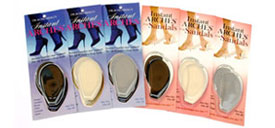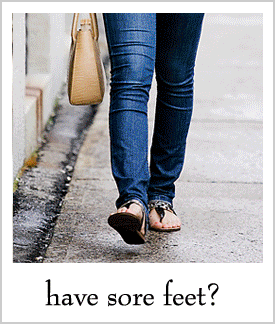Why are arch supports so important for your feet when wearing shoes!
Arch supports will ultimately change the body’s posture when placed in shoes because it changes the posture of the arch of the foot. When Instant Arches® are placed in your shoes; it will contour the arch of the foot and prevent soft tissue compression by stopping the arch from collapsing to the floor in a shoe. Its function is to improve the quality of one’s life during their daily activities such as work, play or when exercising /working out.
Instant Arches® is the ultimate foot care product for men and women. It is a multi-dimensional and functional product that when placed in shoes control the biomechanics of the foot.
“Bad foot genes” are the reasons why foot problems occur. Yes, “Blame it on Mom and Dad”. Arch supports can counteract the predisposition of developing foot problems. They reduce the triggering mechanism to foot pain, bunion pain, joint pain, heel spur pain and arch pain when wearing in fashion footwear. Arch supports also will prevent abnormal foot pronation, arch cramps, and muscle spasms in the foot from occurring because they support as well as stabilize the joints in the mid-foot (mid-tarsal joint) and hind foot (subtalar joint) from collapsing. Flat feet are a byproduct of the arch collapsing and when the foot hits the ground everything changes. This collapsing is known as abnormal pronation, a three plane motion that causes the flattening of the foot to the ground. A flat foot is a congenital foot deformity and is present at birth. Instant arches® are arch supports can help prevent foot problems in children and adults by slowing down abnormal pronation.
No matter what type of foot problem you may have, when you place arch supports in your running, tennis, open or closed shoe styles, sandals or high heels your foot will automatically become more supported, comfortable and improve the ware pattern of your shoes.
All shoes will eventually brake down and force you to take them to the shoe repair shop. The most common shoe repair on a shoe is the heel counter, secondly is the sole of the shoe. Normally, when shoes ware down it is at the outside aspect of the heel, the heel wares down because the instability of the joints in the foot and muscle imbalances in the arch of the foot. During the walking cycle your foot when wearing shoes hits the ground in an inverted position and then proceeds to collapse towards the ground. When the shoe hits the ground your shoe flattens out and the ware pattern travels towards the sole, then to the ball of the foot and eventually out under the great toe. The degree of collapsing that occurs as the shoe approaches the ground will wear down the outside edge, sole and toe area of the shoe due to rough walking or exercises surfaces such as pavement, asphalt or tile floors.
Without the proper arch support in your shoes, regardless of style, there is a greater tendency for the outer sole of the shoe to ware out. This could lead to soft tissue injuries in the foot from repetitive overuse of wearing unsupportive worn out shoes.
Soft tissue injuries that can are commonly found in the foot and lower leg due to repetitive overuse activities and can be reduced by wearing arch supports are shin splints, metatarsalgia (ball of the foot pain) and plantar fasciitis.
Plantar fasciitis
Fascia is a specialized connective tissue that protects, separates structures and keeps them in place. Plantar fasciitis is a stain or partial rupture of the plantar fascia ligament that originates in the heel bone and inserts into the ball of the foot. The cause of injury to this ligament is repetitive over stretching due to repetitive movements of the foot flattening out or arch collapse. Using an arch support will prevent the collapse of the arch and reduce the probability of plantar fasciitis from developing.
Metatarsalgia
Burning pain in the ball of the foot due to repetitive continues micro trauma to the metatarsal heads. The trauma can cause metatarsal head bursitis and or periostitis. Commonly found when women wear high heels and have a long metatarsal bone. Predominately found plantar to the second and third metatarsal bones because those metatarsals are often times longer than the 1st, 4th and 5th metatarsals. The downward pitch of a high heeled shoe forces the metatarsal bones downward towards the floor surface of the shoe in the toe box. Most fashion footwear does not have adequate support in the arch area of the shoe or cushioning in the toe box. The metatarsal bones become inflamed and very painful. The addition of an arch support in a high heel shoe will reduce the impact load on the ball of the foot and spread out the weight distribution among the metatarsal heads.
Shin Splints
Problems of the fascia in the lower leg brought on by repetitive activity causing pain. It is frequently associated with flat feet or arch collapse. The flattening of the arch overpowers the muscles in the lower leg causing muscle imbalances and abnormally stretches the muscle attachments to the lower leg bone. Wearing arch supports to prevent the arch from flattening will reduce the chance of occurrence of shin splints.


 Have a High Arch? Say Goodbye to Foot Discomfort w/ Instant Arches
Have a High Arch? Say Goodbye to Foot Discomfort w/ Instant Arches